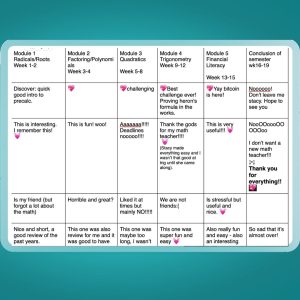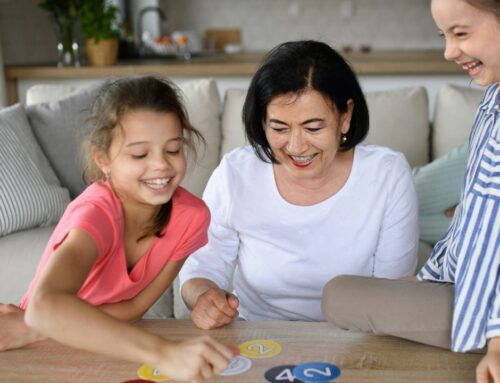Careers in science, technology, engineering and math (STEM) are becoming ever more important, and at SelfDesign, learners who finish grade 12 with a Dogwood Diploma have the same opportunities to pursue post-secondary studies and careers in STEM as any other learners who graduate from high school in B.C.
At SelfDesign® Learning Community, we are applying cutting-edge educational research to our approach to supporting learners as they build their math skills and become comfortable working with numbers and equations.
Math anxiety in schools and society
“The rate of math anxiety and fear of math is increasing generally,” says Stacy Chirico. As a long-time public-school math teacher, a math tutor, a member of our Education Program’s Curriculum Development team, and a learning specialist for our grade 10 Foundations of Math, grade 12 Pre-calculus and our new Grade 8–9 and Grade 11–12 math offerings, Stacy has encountered math anxiety regularly in young people over the last two decades.
“What I used to teach in Math 9 about 20 years ago is now more like Math 11,” she says. “I could see it when I was teaching in the classroom, and I see it in the requests I get for tutoring support.”
Math anxiety, or fear of math, is not a new phenomenon, nor is it limited to young people or to B.C. schools — the trend is occurring across North America and beyond. American psychologists coined the term, “number anxiety,” in a research paper published in the Journal of Educational Psychology in 1957, and researchers, psychologists and educators have been tracking and trying to turn the trend around ever since.
Math anxiety refers to feelings of fear, tension, and apprehension that some people experience when engaging with math. Studies show that, in math-anxious people, math can increase their heart rate and stress hormones and even compromise how their memory works — similar to the way phobias affect people.
And the fear of math, math anxiety, numbers anxiety, or discomfort with numbers presents a significant hurdle in developing the STEM-related skills required to meet the needs of a global society and solve the challenges facing the world today.
“At the end of the day, we need the right answers in math,” Stacy says. “Engineers can’t have the bridges they design collapse because ‘Oops, I forgot to take the square root. Let’s do it again.’ If an engineer, a pilot, or a surgeon does that, they’re looking at huge trial and error — and they’re risking lives.”
So what is SelfDesign doing to support learners and help them become comfortable working with math, numbers and equations as part of their interest-driven learning?
The Thinking Classroom at SelfDesign
 All learners in grade 10 start their math journey by taking Workplace Math 10 in their first semester. The course provides important and practical skills as learners transition into independence. It also helps learners brush up on their math skills, and get used to receiving assessments and the rhythm of SelfDesign’s unique thematic approach to grades 10 to 12. We recently received a commendation from the BC Ministry of Education and Child Care inspectors for this plan.
All learners in grade 10 start their math journey by taking Workplace Math 10 in their first semester. The course provides important and practical skills as learners transition into independence. It also helps learners brush up on their math skills, and get used to receiving assessments and the rhythm of SelfDesign’s unique thematic approach to grades 10 to 12. We recently received a commendation from the BC Ministry of Education and Child Care inspectors for this plan.
In addition, we draw on recent research and work by Peter Liljedahl, a professor in Simon Fraser University’s Faculty of Education, to apply the Thinking Classroom approach to math at SelfDesign. [Liljedahl has posted an account of how he came up with the approach on his website.]
We piloted the Grade 8–9 Thinking Classroom add-on course in early 2021. And, beginning this learning year, we’re offering a Thinking Classroom math offering for grades 8–9 in the fall and spring.
The goal is to have learners engage with math problems — to truly think about them and analyze them deeply — and to experience enough “Eureka!” moments of discovery and success in the process of solving each problem so that they remain interested and persevere through the tricky bits.
Learners work together in groups of three or four to solve math riddles and puzzles that are meaningful to them. In brick-and-mortar classrooms, the groups work on whiteboards around the classroom. At SelfDesign, the groups collaborate on the problems on digital whiteboards in real-time meeting breakout rooms on SelfDesign’s online communications platform.
But the key thing about the Thinking Classroom approach, says SelfDesign Educational Program team lead Janice Green, is that everybody’s work is available to everybody else in the class. “
“It’s like a gallery walk,” she says. “You’re allowed to go to another group and look at what they’re doing. You’re allowed to see how the other groups are going about solving the same problem you’re working on — like, it’s not a secret, right? And when you can do this, you can see, ‘Oh, this group did it this way!’ and be inspired by that and use it to maybe overcome a tricky part of the problem that you might be stuck on. And that’s when it clicks, right? It doesn’t click when a teacher is lecturing, showing you how it’s done — it clicks when you figure it out yourself.”
One learner who participated in the Grade 11–12 Pre-calculus course in 2021–2022, where Stacy also applied the Thinking Classroom approach, told us, “I really like this style of real-time meeting learning because we get to figure it out ourselves, and personally, that has helped me a lot more than being told how and what to do because afterwards, I can do it on my own.”
“I found that learning math with others in the meetings is really fun,” another learner shared. “I am able to connect with my peers, and we help each other not just with math but with simple things like different functions of computer keys.”
According to both Janice and Stacy, many SelfDesign educators have been applying a similar approach with learners for decades without realizing it.
“Thinking Classroom is not a huge stretch here at SelfDesign,” Janice says. “It’s natural for our general approach to real-time meetings, and I think that’s why I love it so much. Because I’ve already been doing something very like it for years, and I never knew what it was, but it’s now like, ‘Wow! Someone went out and gathered the data and actually wrote a book about the way we teach! That’s so cool!’”
Fun and fundamentals in math
Stacy introduced Thinking Classroom to her brick-and-mortar math classes about a decade ago and helped design, as well as piloted, the Thinking Classroom Math courses here at SelfDesign Learning Community. She says one of the interesting challenges she has encountered as a learning specialist for grade 10–11 math at SelfDesign is the range of math abilities among learners.
“Some learners are missing some fundamentals, while others understand some calculus-level math because they went ahead on their own in their learning,” she says. “So it was important to find a language that all the learners, whatever their math abilities, have in common to bring these kids together.”
The language she finds works best, whether online at SelfDesign or in brick-and-mortar classrooms, is story.
“I am just really good at storytelling,” she says, admitting that before she fell in love with math in high school, she had been considering a career as a writer. “It could be my own personal story. It could be a riddle. It could be a Greek myth, or whatever. I bring something in that the learners can relate to, and I start any lesson — even, you know, the grade 12 horizontal asymptote lesson — by bringing in a story to make it relevant.”
And out of the stories come the riddles and puzzles to challenge the learners.
“I look for good math problems — something that will encourage the learners to think critically and assess and approach the puzzle or riddle in a spirit of inquiry,” she says. “Because in a thinking classroom, we need something to think about, and we need to train the learners to think about the problems with the gifts for math that, in reality, they already have. We need to help them access what they already have and use it.”
One thing she recommends to parents of SelfDesign learners in younger grades is to make sure their children grasp multiplication and division and have mastered those basic math skills.
“Don’t underestimate the power of the multiplication table,” she says. “It’s more than just memorizing — and I say that as a math educator who is free thinking about math. Don’t underestimate the importance of the basics, because that’s going to free learners’ math spirit in the long run. Once they have that foundation, the possibilities are endless — including possibilities for fun.”
As one learner who took part in the Thinking Classroom Math pilot says, “I found that generally, the way that I have learned math in classrooms in the past hasn’t really clicked with me. During this course, however, I was drawn to how it seemed to bring more exploration into math. I loved how I could use discovery and problem-solving skills in a math environment. I also enjoyed how social and friendly everyone in the course was, and joining breakout rooms with other students was always a fun way to work on problem-solving, as well as hearing the opinions and ideas of everyone around me.”
Janice says the Thinking Classroom approach has even changed how she feels about math.
“I never was afraid of math, but I never enjoyed it. I had to work exceptionally hard at it, and I didn’t like it,” she says. “And now — in my adulthood! — finally, I love it. I love it! And in the last two, three years, I’ve attended math conferences, which I would never have done before because I’d always felt way out of my element. But now, I feel okay. It’s like if I go in with Thinking Classroom in mind, I feel like I know what I’m doing.
“It’s actually kind of beautiful.”
Building on the success of the math offerings, the SelfDesign Education Programs team is exploring how they can apply the Thinking Classroom approach more broadly with all grades and subjects.
Learn more about paths to completion at SelfDesign® Learning Community>
Learn about the many different kinds of educators at SelfDesign>







